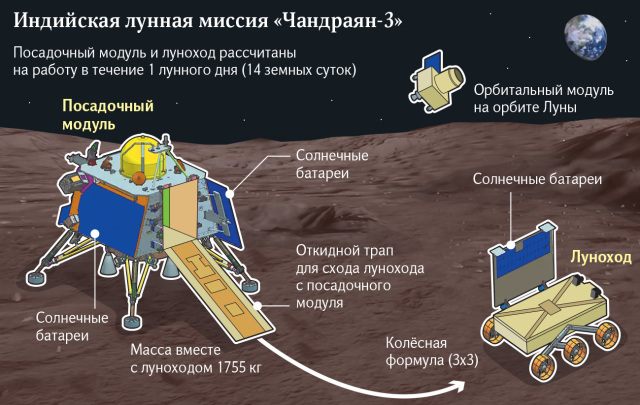As the scientists noted, this discovery confirms the theory about the process of moon formation.
TASS, August 21. The lunar rover of the Chandrayan-3 mission studied the chemical composition of rocks at the south pole of the Moon and found evidence that a significant part of the southern circumpolar regions of the Earth's satellite arose as a result of the solidification of a giant "magma ocean" in the early epochs of the Solar System. This discovery confirms the theory about the process of moon formation, the researchers write in an article published in the journal Nature.
Read also What is known about the Indian interplanetary vehicle Chandrayan-3
"We used the APXS X-ray spectrometer on board the Pragyan lunar rover to study the composition of rocks at 23 different points at the south pole of the Moon, located near the landing site of Chandrayana-3. These measurements indicated that this part of the Moon's surface is covered with a layer of ferroan anorthosites, which arose as a result of the slow solidification of the "magma ocean," the study says.
This is the conclusion reached by Indian planetary scientists under the guidance of a professor at the Physical Research Laboratory in Ahmedabad Santosha Wadvale studied the data collected by the scientific instruments of the Pragyan lunar rover, which was delivered to the surface of the Moon a year ago by the Chandrayan-3 mission. After landing, the rover traveled over 100 m across the surface of the Moon and conducted 23 series of measurements in the vicinity of the craters Mancini and Boguslavsky using the APXS spectrometer.
These measurements, according to scientists, allowed them to estimate the amount of silicon, titanium, aluminum, iron, manganese, magnesium, calcium and other elements in local lunar rocks, determine their mineral composition and determine how much the neighboring regions of craters and flat areas of the circumpolar regions of the Moon differ from each other in this regard. Such data, as scientists note, is very important for verifying the correctness of similar measurements that are carried out using orbiting lunar probes.
The calculations carried out by the researchers indicated that the rocks at all 23 points on the surface of the Moon, which were studied by Pragyan, consisted of a similar set of rocks, in which the minerals that form the basis of the so-called ferroan anorthosites played a dominant role. This is what geologists call a special class of rocks, which is usually formed as a result of the slow solidification of large accumulations of magma on Earth and other rocky planets.
Similar but slightly different anorthosites were also found in the equatorial regions of the Moon by the Soviet Luna-20 and the participants of the Apollo 16 mission. According to scientists, the presence of these minerals in the vicinity of the Moon's south pole confirms the hypothesis that almost all heavy lunar minerals ended up in the deep layers of its interior, and light minerals "surfaced" to its surface during the solidification of the global magmatic ocean that covered the Moon in the first epochs of its existence.
About the Chandrayan-3 mission
At the end of August 2023, the descent module of the Chandrayan-3 mission successfully landed near the South Pole of the Earth's satellite. India became the fourth country in the world to make a soft landing on the Moon - after the USSR, the USA and China, and the first country to make a soft landing at the south pole of the Moon. "Chandrayan-3" and the rover "Pragyan" delivered to the Moon for 14 days of work collected a lot of valuable information about the structure of the bowels of the south pole of the Earth's satellite.

